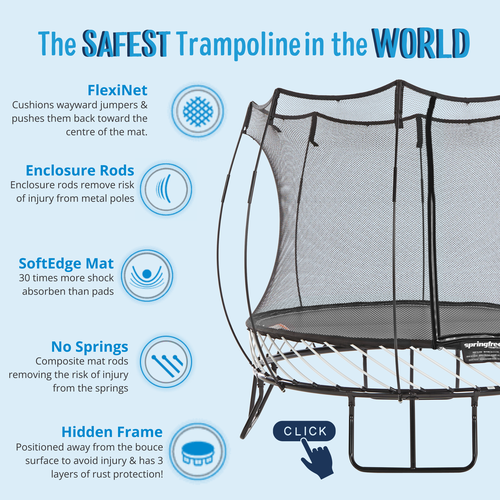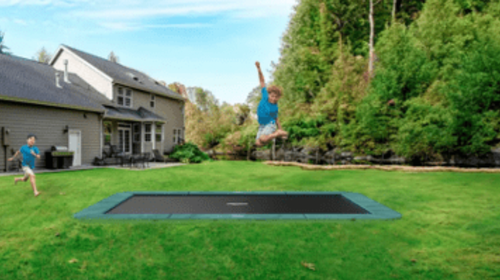Avoid the common trampoline trap! Expert insights on why quality matters and how to select the best type of trampoline for your needs.
5 MIN READ
As you scroll through trampoline after trampoline, you might be wondering: “Does the type of trampoline matter?”
At first glance, a £300 trampoline might seem comparable to a high-quality trampoline.
But buying a cheap trampoline that seems “good enough” is maybe the number one mistake we see consumers make.
We’re going to use this blog to discuss:
Why the trampoline type (and quality) matters.
The different trampoline types you can buy.
How to find the best trampoline in your budget.
Are All Trampolines the Same?
Not all trampoline types are created equal.
The type of trampoline you buy can literally make or break your happiness with your purchase.
It’s just like any product: If you buy the cheaper, off-brand model, it’s not going to be as good as the higher-end model.
It’s not all about quality, though.
There are different types of trampolines built for specific people. Let’s cover those first before circling back to quality.
The following are the common types of trampolines:
Spring Trampolines - Traditional trampolines that use metal springs to connect the jumping mat to the frame.
Springless Trampolines - These trampolines replace springs with other forms of elastic material (i.e. composite rods) to provide a safer bouncing surface.
Inground Trampolines - Trampolines designed to be installed at ground level (more on these later).
Rebounder Trampolines - Compact, portable trampolines primarily used for fitness workouts and therapeutic exercises; typically used as a trampoline for adults.
Toddler Trampolines – Small indoor trampolines with safety features designed for young children.
Gymnastic Trampolines - High-performance trampolines with a larger surface area and more powerful bounce, used by athletes for training.
Water Trampolines - Floating trampolines designed for use on water.
The most common trampoline type is the garden trampoline (the one you had as a child).
That is our expertise and what we will focus on in this article.
Particularly, we’re going to highlight trampolines with springs and trampolines without springs.
We’ll touch on inground trampolines, as well. These differ significantly from above-ground trampolines.
Spring vs. Springless Trampolines
A trampoline will either have metal springs or alternatives like composite rods.
What are the differences between these two types of trampolines?
There are five fundamental differences between spring and springless trampolines, including:
Safety – Springless trampolines are safer due to their elimination of the springs, which cause around 20 percent of trampoline injuries.
Design – Spring trampolines have that classic feel to them. Springless trampolines are unique in their appearance.
Bounce – Spring trampolines create the bounce by the springs stretching and recoiling. The rods on a springless trampoline flex when jumped on and store energy – resulting in a softer and more controlled bounce.
(It’s debatable which trampoline type produces a higher bounce. It depends on factors like the quality of the trampoline springs, the weight of the user and the overall construction of the trampoline.)
Durability – The rods on a springless trampoline will usually last longer than the springs on a traditional trampoline. Metal springs usually need to be replaced every 1-3 years (although there are exceptions).
Cost – Springless trampolines are more expensive than most spring trampolines. The unique build means that it costs more to make a springless trampoline than the average trampoline.
Springless trampolines are safer, have a gentler bounce and last longer. But they are usually more expensive.
Example of Springfree Trampolines’ safety features:
Spring trampolines have a classic appearance and will likely be cheaper upfront. However, the springs can cause painful pinching injuries and require strict maintenance (and eventually replacements).
Whether you’re a fit for a trampoline with springs or without will be based on your preferences.
However, the spring vs. springless debate will be the first one you need to settle when deciding on a trampoline type.
What About In-ground Trampolines?
The other trampoline type worth mentioning is inground trampolines.
Inground trampolines are installed at ground level, like so:
Photo courtesy of BERG Toys.
Families that install trampolines in the ground do so for a few reasons:
1. They are more “hidden” than above-ground trampolines.
2. They eliminate the chances of falling off the trampoline completely.
3. They won’t be blown away by the wind.
4. They are easier to access (i.e. entry/exit).
However, inground trampolines can cost over £5,000 to install (not a typo).
Since they are installed into the ground, it usually requires professionals to properly dig a hole, build a retaining wall and ensure proper water drainage.
Photo courtesy of Trampoline Holes.
Not to mention, inground trampoline kits cost over £1,000.
Due to the large upfront cost, complicated installation, and permanent status (once it’s there, it’s hard to move) in-ground trampolines aren’t practical for most families.
That’s why most trampolines (either spring or springless) are assembled above the ground.
The Importance of Trampoline Quality
Now that we’ve covered the trampoline types, it’s time to come back to quality.
Trampoline quality is directly tied to safety and longevity. You can’t have one without the other.
Cheap trampolines are cheap for a reason.
They aren’t built to last past 1-3 years without replacing parts.
Quality is the main difference between a £300 trampoline and a £1,000+ trampoline.
Example of a cheap trampoline, listed at £219 on Skywalker Trampolines' website:
Photo courtesy of Wayfair.
But what makes a quality trampoline?
A high-quality trampoline will contain the following features:
A powder-coated galvanised steel trampoline frame that is rust-resistant and provides structural integrity.
A strong, flexible and UV-resistant enclosure net.
Padding over the trampoline springs or a springless design.
Curved or well-padded trampoline poles.
A UV-resistant mat with no hard edges.
Metal parts should all be UV-treated.
A long trampoline warranty period (5-10 years).
A high single-jumper trampoline weight limit.
MUST be ASTM-certified (American Society for Testing and Materials, the leading organisation behind trampoline standards).
Example of a high-quality trampoline, listed at £1,495:
Springfree Trampoline.
The trampoline type matters for both kids and adults, but quality is equally as important.
If you don’t get a quality trampoline, there’s no guarantee that the type of trampoline you buy will:
1. Last for the long haul.
2. Keep you and your kids safe.
3. Perform as expected.
Expert Advice: When buying a trampoline for your child (or family), spend the money upfront for a quality trampoline if you’re seeking a safe, long-term trampoline. It’s not worth the headache or safety risk to keep recycling through £200-£400 trampolines.
How Do I Know Which Trampoline to Buy?
The answer to the “Does the type of trampoline matter?” question is unequivocally YES.
But it’s not just the type of trampoline that determines your purchase.
Trampoline quality is equally if not more important.
But there are plenty of quality trampolines for all trampoline types.
Any questions, give us a call 01276 477461!












